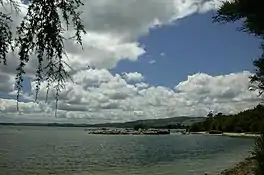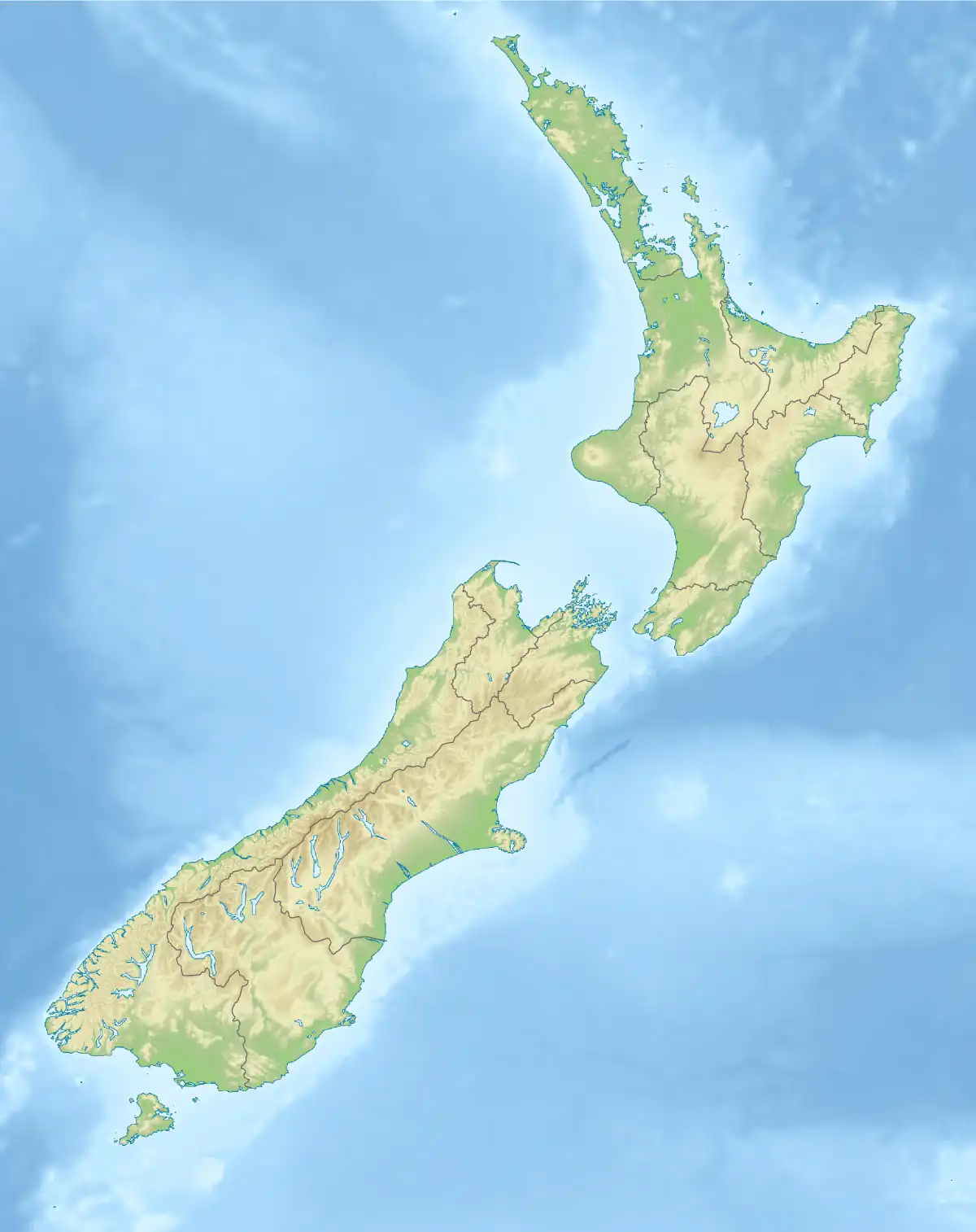| Lake Rotorua | |
|---|---|
| Māori: Te Rotorua nui ā Kahumatamomoe | |
 Lake Rotorua | |
 Lake Rotorua  Lake Rotorua | |
| Location | Rotorua Lakes, Bay of Plenty Region, North Island |
| Coordinates | 38°05′S 176°16′E / 38.083°S 176.267°E |
| Type | crater lake |
| Primary inflows | Utuhina, Hamurana Spring, Ngongotahā |
| Primary outflows | Ohau Channel |
| Basin countries | New Zealand |
| Max. length | 12.1 kilometres (7.5 mi)[1] |
| Max. width | 9.7 kilometres (6.0 mi)[1] |
| Surface area | 79.8 square kilometres (30.8 sq mi)[1] |
| Average depth | 10 metres (33 ft)[1] |
| Max. depth | 45 metres (148 ft)[1] |
| Surface elevation | 280 metres (920 ft)[1] |
| Islands | Mokoia Island |
| Settlements | Rotorua |
| References | [1] |
Lake Rotorua (Māori: Te Rotorua nui ā Kahumatamomoe) is the second largest lake in the North Island of New Zealand by surface area, and covers 79.8 km2.[1] With a mean depth of only 10 metres it is considerably smaller than nearby Lake Tarawera in terms of volume of water. It is located within the Rotorua Caldera in the Bay of Plenty Region.
Geography
Lake Rotorua is fed with water from a number of rivers and streams; some such as the Utuhina flow with a water temperature warmer than the lake due to the thermal activity in the Rotorua area. Conversely streams on the northern shore such as the Hamurana Spring and the Awahou stream flow crystal clear water that has a constant temperature of 10 degrees Celsius. Other notable tributaries include the Ngongotahā stream, famous for trout fishing. Lake Rotorua flows directly into Lake Rotoiti via the Ohau Channel at the north eastern corner of the lake. The urban development of Rotorua extends along the south portion of the lake shore.
Geology
The lake was formed from the crater of a large volcano in the Taupō Volcanic Zone. Its last major eruption was about 240,000 years ago.[2] After the eruption, the magma chamber underneath the volcano collapsed. The circular depression left behind is the Rotorua Caldera, which is the site of the lake.

The lake as shown in Figure 1, has had periods at multiple different lake levels since the caldera's Mamaku ignimbrite eruption, related to both volcanic activity and subsidence within the Taupō Rift.[3] The lake all time high occurred sometime after the formation of the Ngongotahā Dome which records this on its flanks, and is now dated at 200,000 years.[4]: 149, 171 Previously this dome's eruption was assigned much closer to the time of the Mamaku ignimbrite eruption, so the lake maximum high stand was assumed to be more directly related to the caldera's formation. Breakout floods are suspected through the Hemo Gorge after the lake's maximum high stand, definitely after the Rotoiti eruption of the Ōkataina Caldera, with formation of a channel within the western lake floor of Lake Rotoiti and suspected after the Hauparu eruption throught the Kaituna River Gorge.[3] Several other lakes of volcanic origin are located nearby to the east, around the base of the active volcano Mount Tarawera and these also over time have varied in size or existence due to volcanic action.
Mokoia Island, close to the centre of the lake, is a much later rhyolite dome compared to Ngongotahā.[2][4]: 150 It is probably New Zealand's best-known lake island, and is closely associated with one of the best-known Māori legends, that of Hinemoa and Tutanekai. Is said that Hinemoa swam across the lake to her lover Tutanekai who lived on Mokoia Island.
Owing to the geothermal activity around the lake (including still active geysers and hot mud pools), the lake has a high sulphur content. This gives the lake's waters an unusual yellowish-green hue.
Tourist attraction

Despite the large volume of water flowing through Lake Rotorua its shallow depth makes it very prone to discolouration, especially from sediment following windy weather. It is well used by fishermen, but less popular with watersports participants and swimmers.
The Ohau Channel is navigable by boat and is also favoured by fly fishermen. The Ohau channel joins at the Mourea delta, an area with very low water levels. This area is frequented by novice kayakers and swimmers. Nearby is the ancestral land of the Ngati Pikiao hapu of the Te Arawa tribe. From Lake Rotoiti the waters of Lake Rotorua flow to the Kaituna River into the Pacific Ocean near Maketu; the rapid descent from over 900 feet above sea level in less than 20 km has created an area used for extreme kayaking and white water rafting.
See also
References
- 1 2 3 4 5 6 7 8 Lowe, D.J.; Green, J.D. (1987). Viner, A.B. (ed.). Inland waters of New Zealand. Wellington: DSIR Science Information Publishing Centre. pp. 471–474. ISBN 0-477-06799-9.
- 1 2 Bégué, F.; Deering, C. D.; Gravley, D. M.; Kennedy, B. M.; Chambefort, I.; Gualda, G. A. R.; Bachmann, O. (2014). "Extraction, Storage and Eruption of Multiple Isolated Magma Batches in the Paired Mamaku and Ohakuri Eruption, Taupo Volcanic Zone, New Zealand". Journal of Petrology. 55 (8): 1653–1684. doi:10.1093/petrology/egu038. hdl:20.500.11850/88102.
- 1 2 Marx, R; White, JD; Manville, V (15 October 2009). "Sedimentology and allostratigraphy of post-240 ka to pre-26.5 ka lacustrine terraces at intracaldera Lake Rotorua, Taupo Volcanic Zone, New Zealand". Sedimentary Geology. 220 (3–4): 349–62. doi:10.1016/j.sedgeo.2009.04.025.
- 1 2 Ashwell, Paul Allan (2014). Controls on rhyolite lava dome eruptions in the Taupo Volcanic Zone (Thesis). doi:10.26021/7632. Retrieved 2 October 2023.
